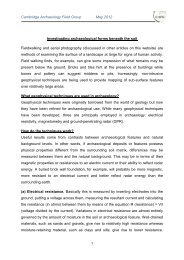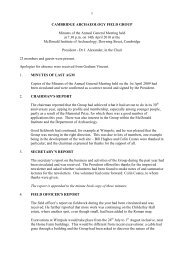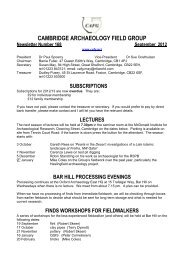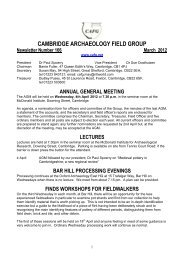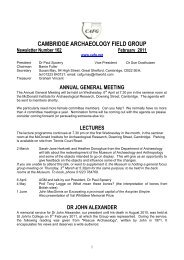Recognising man-made flints - Cambridge Archaeology Field Group
Recognising man-made flints - Cambridge Archaeology Field Group
Recognising man-made flints - Cambridge Archaeology Field Group
You also want an ePaper? Increase the reach of your titles
YUMPU automatically turns print PDFs into web optimized ePapers that Google loves.
<strong>Cambridge</strong> <strong>Archaeology</strong> <strong>Field</strong> <strong>Group</strong><br />
1<br />
October 2012<br />
<strong>Recognising</strong> <strong>man</strong>-<strong>made</strong> <strong>flints</strong>: a short guide<br />
These notes are intended to provide CAFG members with guidance on how to<br />
distinguish <strong>man</strong>-<strong>made</strong> flint tools from the <strong>man</strong>y natural broken and fractured <strong>flints</strong><br />
seen when fieldwalking. Mastering this subject requires expertise and a great deal of<br />
experience – this short guide provides a simple starting point and an introduction to<br />
the terminology used. Photos are from items held in the CAFG flint collection.<br />
Why flint?<br />
Flint is a remarkable natural material. It is one of the most durable of rocks: providing<br />
an edge sharper than a metal razor and second only to diamond in hardness. It is of<br />
particular value in making tools because, when struck, it fractures in a predictable<br />
way. Flint has a softer outside skin known as the cortex. Generally white or buff, this<br />
can acquire a brown or greyish stain depending on soil and its mineral content.<br />
Although flint is quite widely available, especially in the south of England, in some<br />
cases alternative materials were sometimes used in a similar way – for example chert<br />
which has a coarser crystalline structure.<br />
Making flint tools<br />
In order to identify <strong>man</strong>-<strong>made</strong> flint tools it is helpful<br />
to understand how they were prepared from flakes<br />
struck from a flint nodule. To make a flake<br />
successfully it is necessary to have a flat surface<br />
called a striking platform, as shown in Figure 1.<br />
This might be a natural feature of the flint nodule or<br />
prepared by removing material with a blow from a<br />
hammerstone.<br />
The arrow shows the angle necessary to strike off<br />
the flake. The remaining nodule shows traces of<br />
removed flakes and is known as the core. Most of<br />
the <strong>man</strong>-<strong>made</strong> <strong>flints</strong> we see when fieldwalking are<br />
either flakes or cores. Photo 1 shows an example of a core.<br />
Figure 1. A diagram of a core,<br />
showing the flat striking<br />
platform at the top, and a struck<br />
flake.
Flakes that are <strong>man</strong>-<strong>made</strong> show<br />
key features that result from this<br />
knapping process and they are<br />
shown in Figure 2. Expect to see<br />
ridges on the dorsal (outside) part<br />
of the flake and ripples on the inner<br />
(ventral) side. There will also be a<br />
‘bulb of percussion’ at the point<br />
where the flake was struck off and<br />
from which the ripples radiate. The<br />
profile of the flake will often have a gentle curve.<br />
Figure 2. Characteristic features to be found on<br />
a <strong>man</strong>-<strong>made</strong> flake.<br />
A flake is called a blade if its length is twice its width and it has parallel edges and<br />
ridges on the dorsal side while blades less than 12mm wide are known as bladelets.<br />
Some examples of bladelets are shown in Photo 2. The unwanted pieces of flint struck<br />
off in the <strong>man</strong>ufacturing process are called debitage.<br />
Photo 1. An example of a flint core<br />
found at Lode.<br />
A flake will usually have a sharp edge which can be used as a blade for cutting without<br />
any further work. However, depending on the type of use to which it will be put, the<br />
flake may have been subject to further shaping to create the ideal shape or re-<br />
2<br />
Photo 2. Examples of bladelets found at<br />
Over.
sharpening to create a suitable edge. This is called reworking and Photo 3 shows this<br />
quite clearly.<br />
Types of tools<br />
Nodules and flakes can be developed into a number of different tools. For example:<br />
Scrapers are a commonly found flint tool. They vary considerably in quality and<br />
shape. They may have been used for a variety of tasks, such as scraping fat<br />
from skins and for working wood. Two examples are shown in photos 3 and 4.<br />
Piercers and awls. Used for making holes in skins and wood. A small example<br />
is shown in photo 5.<br />
Knives – for all purposes. Often a simple flake with an un-retouched straight<br />
cutting edge – but they may also have been retouched.<br />
Axes, including hand axes for cutting meat and hafted axes for tree and other<br />
cutting and chopping tasks. See two examples in photos 7 and 8. More<br />
ceremonial axes, like that shown in photo 7, were ground with sand to produce<br />
smooth surfaces and idealised shapes.<br />
Microliths – small pieces of flint which were attached to wood to make cutting<br />
edges e.g. for arrow heads and scythes. These can be hard to see when<br />
fieldwalking. See photo 6.<br />
Arrow heads – these often represent the pinnacle of flint working, requiring<br />
much re-touching to achieve the ideal shape. See photo 9 and 10 for examples.<br />
Photo 3. A scraper found at<br />
Willingham<br />
3<br />
Photo 4. A scraper found at<br />
Landbeach.
Photo 5. An awl found at<br />
Granchester.<br />
Photo 7. Polished Neolithic stone<br />
axe found in Landbeach.<br />
Photo 9. Leaf-shaped arrowhead<br />
found in Lode.<br />
4<br />
Photo 6. A series of microliths<br />
found at Hawkecombe.<br />
Photo 8. Paleolithic hand axe<br />
found in Histon.<br />
Photo 10. Tanged and barbed<br />
arrowhead found in Lode.
How to distinguish worked flint from natural flakes<br />
There are a number of features to bear in mind when examining a likely looking flint.<br />
You should ask yourself:<br />
Does the flint have a bulb of percussion and striking platform?<br />
Are there ripples radiating across the inner face of the flake?<br />
Are there any signs of retouching? Many <strong>flints</strong> used as tools show evidence of<br />
retouching.<br />
Is the flake the result of modern mechanical action? Ploughs can produce quite<br />
convincing flakes with prominent bulbs of percussion – but usually there is no<br />
associated striking platform or any signs of re-working.<br />
Does it have a crazed surface? Burnt flint is thought to have been used to heat<br />
water in containers.<br />
Are the small circular scars caused by frost fracturing?<br />
Is it a 'pot lid'?<br />
If in any doubt, ask a more experienced colleague.<br />
Photo 11 shows an example of burnt flint. They have a crazed surface and are often<br />
grey/white in colour. They are believed to have been used to heat water and the<br />
presence of quantities of burnt flint may indicate the presence of an occupation site.<br />
Photo 12 shows frost pitting: one of the effects weathering can have on <strong>flints</strong><br />
Photo 11. Typical piece of burnt<br />
How flint old found is it? in Lode.<br />
5<br />
Photo 12. Frost pitting of a flint<br />
nodule found in Lode.
Flint tools were <strong>man</strong>ufactured for over half a million years. Once <strong>made</strong>, they never<br />
decayed so it is, therefore, not surprising that they can be found when fieldwalking.<br />
Dating flint requires a great deal of practical experience. However, the following gives<br />
a broad indication of the historic periods and tool types associated with them.<br />
Palaeolithic – 600,000 to 10,000 Before Present<br />
Hand axes predominate (useful for <strong>man</strong>y purposes including butchering<br />
animals – a reflection of the hunter gatherer life?) Later, long blades were used<br />
to make a whole range of different tools.<br />
Mesolithic 10,000 to 5,400 BP<br />
New designs were developed based on hunting equipment. Microliths were<br />
used to make tools. The adze, rather than the axe, was mainly used. The<br />
range of tools probably reflected changes in the way people lived.<br />
Early Neolithic 5,400 to 5,000 BP<br />
The adze largely disappears to be replaced by the polished or flaked axe.<br />
Microliths and other composite tools disappear. Leaf shaped arrow heads<br />
make their appearance (perhaps the clearance of woodland meant more<br />
effective arrowheads were required). Some polished axes move beyond the<br />
purely practical and become desirable status objects.<br />
Late Neolithic & Early Bronze Age<br />
Metal tools appear. There is a general decline in the quality of flintwork.<br />
However, tanged and barbed arrow heads are linked with early Bronze Age or<br />
Beaker period.<br />
There is a great deal of written information, academic, on this subject but the following<br />
are recommended as a starting point for the interested amateur:<br />
Butler, Chris. 2008 Prehistoric Flintwork, The History Press Ltd.<br />
Oakley, Kenneth P. 1972 Man the toolmaker, Natural History Museum Publications;<br />
6th Revised edition.<br />
Lord, John W. 1993. The Nature & Subsequent Uses of Flint. Published by author.<br />
6<br />
Version 0.1<br />
Robert Skeen



